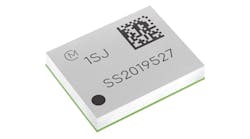Murata has expanded its Type 1SJ product line with the addition of a new LoRaWAN modem solution. The AT-Command-controlled modem module version measures only 10.0 mm × 8.0 mm × 1.6 mm, which the company claims is the smallest available in the world today. Operating from a single supply rail up to 3.9 V dc, the device incorporates several low-power modes that allow the real-time clock (RTC) to operate while drawing a typical current of just 1.3 µA. With current consumption so minute, a single battery could run the device for years. Additionally, the resin-mold package provides physical ruggedness with a –40 to +85ºC temperature range.
Based on a second-generation Semtech SX1262 RF IC, the Type 1SJ LoRaWAN modem module comes preloaded with AT Command-controlled modem firmware and a LoRaWAN stack with an AT-Command middle layer. These features enable a faster time-to-market and ease design challenges for IoT developers. The device currently supports the U.S. 915-MHz band in North America. Future adaptations of the module are intended for Europe, India, China, and Pacific Rim markets. It is suitable for a wide range of applications where a miniaturized footprint, long range, extended battery life, and advanced security are all critical requirements. Examples include asset tracking, utilities, agriculture, smart cities, smart buildings, industrial, and other IoT applications.
The initial launch module supports the U.S. 915-MHz band only, but modules supporting other bands such as the EU868 band will be launched afterwards.

